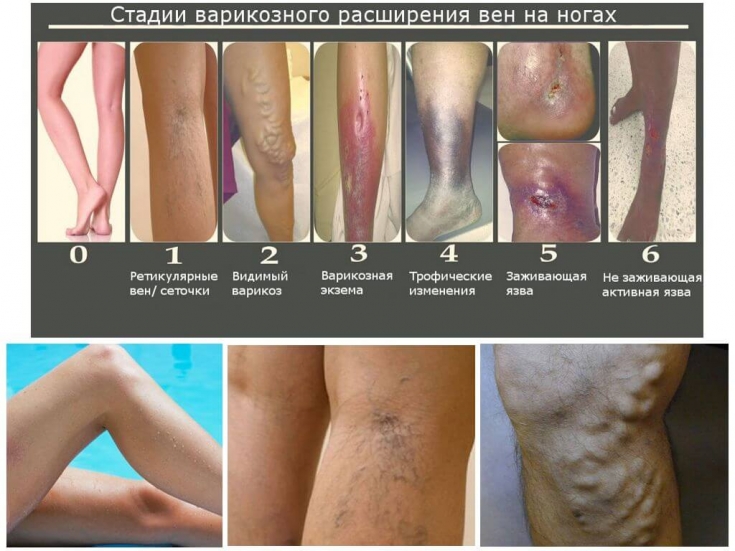Every tenth inhabitant of the planet suffers from the problem of varicose veins in the legs. If earlier varicose veins could be found in the elderly, now this disease occurs in young people after 25 years. Why is the process evolving? Why is varicose veins dangerous and how to identify the process in time? New methods of diagnosis and treatment of varicose veins, read on estet-portal.com.
The main causes of varicose veins in the legs
Varicose veins most often affect the veins of the lower extremities, but this does not exclude the possibility of developing varicose veins of the internal organs, upper extremities, intestines.
The cause of varicose veins in the legs is insufficiency of perforating valves. The pathology of perforating valves can be primary and secondary. Primary insufficiency develops with prolonged and frequent stress on the veins in combination with a person's genetic predisposition to venous pathology.
Do you know How to avoid developing varicose veins?
Secondary insufficiency develops against the background of certain diseases: diabetes mellitus, post-thrombophlebitis syndrome, deep leg vein thrombosis, liver cirrhosis, obesity.

The following factors contribute to the development of varicose veins in the legs:
- Feature of working conditions – a long stay of a person in a standing position, an uncomfortable posture when performing work, as well as in a position in which the popliteal vein is transmitted.
- Bad habits (alcohol, smoking).
- Excess body weight.
- Tall growth.
- Hormonal disorders.
- Pregnancy.
- Women often wear uncomfortable shoes or high heels.
- Heart disease – vascular system and kidneys.
Genetic predisposition occupies a separate place among the causes, since in the presence of varicose veins in blood relatives, the chances of having varicose veins in the legs doubles, and with age, the development of varicose veins is possible even in the absence of the above described factors.

Symptoms of varicose veins. Stages of varicose veins of the lower extremities
Varicose veins are considered a serious and dangerous disease, because it can lead people to disability, along with this, its first manifestations, when the treatment is effective, are not noticeable to the patient. Consider the symptoms of varicose veins in stages.
What are the consequences at different stages of varicose veins
The development of varicose veins has 6 stages:
Stage 0 – This stage is characterized by the appearance of the first symptoms of varicose veins. A person feels heaviness in the legs, sometimes swelling and night cramps are present. As a rule, these complaints do not force patients to consult a doctor. Even if a person seeks help, according to the examination and the results of the study, varicose veins are not detected. This is a feature of stage 0.
Stage 1 – characterized by the appearance of "spider veins" on the legs. The symptoms of varicose veins described above may occasionally appear, but are not always present.
Stage 2 – this stage is already noticeable and very palpable to the patient himself. After sitting in one position and when standing for a long time, noticeable protrusions appear on the veins in the form of nodules. Already at this stage, blood clots may form due to significant stagnation of blood in the lower extremities.
Stage 3 – characterized by the presence, in addition to the above symptoms, swelling in the legs. Edema often appears in the evening, may disappear by morning, but by the next evening they reappear after exertion on the legs.
Stage 4 - characterized by the development of trophic disorders of the tissues of the lower extremities. This can be manifested by the presence of inflammation on the skin, which leads to skin atrophy. The skin on the legs, especially on the shins, becomes dark brown due to the accumulation of pigment. These processes lead to the formation of redness and extensive weeping lesions, which contributes to the development of trophic ulcers.
Stage 5 – at this stage there are trophic ulcers that have the ability to heal.
Stage 6 – at this stage, the blood supply is so disturbed that trophic ulcers do not heal.
If you experience any of the above symptoms, you should seek medical help as soon as possible. Only a specialized clinic can provide a full range of services.
Learn more: Varicose veins - psychosomatics and treatment.
The Vascular Clinic will keep your feet healthy
By contacting Dr. Lirnik's vascular pathology clinic, each patient individually receives highly qualified assistance, which consists of examination, diagnosis, differential diagnosis of processes, as well as a conclusion about the existing condition.
The patient is given advice about their health condition and information about the necessary treatment. This treatment can be either conservative (in the early stages of the process) or surgical (minimally invasive and radical).
Thus, having identified the symptoms of varicose veins, the patient can safely seek qualified medical care at the vascular pathology clinic.
Read: 9 things to know about varicose veins.









Add a comment